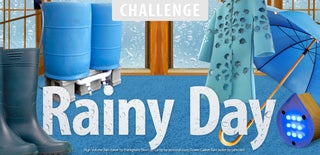Introduction: 4 Ways to Make Multi-Surface LED Throwies - Taggies
Hi everyone,
today I'm publishing my 20th Instructable & YouTube video! To do so I decided to roll 4 Mini Projects into one and hope that you'll like it.
The inspiration for this project came from so called "throwies" which are basically powered LED's with a magnet that can be thrown against metallic surfaces as part of street art projects. Check https://www.instructables.com/id/LED-Throwies/ for more info on the original idea. A second influence was 4WantofaNailsDisaster Preparedness: Communications bundle which featured a small capsule containing a number of mini light sticks that could be used as glowing "bread crumbs" to mark ones path when straying of a trail. The last influence was the memory of working in Iraq & Afghanistan where most cigarette lighters sold on the local bazaars had small build in lighters for times when power cuts would turn the lights off (which was quite often).I liked the concept of simple, cheap & expendable lights for use in outdoor applications but found that the attachment via a magnet was too limited. In this project I showcased four different methods of making simple & cheap throwies each with multiple attachment options. To make a separation between the two I decided to call mine Taggies since that's what you do with them. You can tag/mark yourself, your gear, a path, use them as jewelry or whatever else you want.
Please mind the environment and pick up your taggies whenever possible!!! Lithium batteries as well as the plastic components are harmful for the environment and should be disposed of properly!!!
If you like this Instructable please vote, fav, share, subscribe & comment. You can also check my YouTube, Facebook, Blog, Instagram and Twitter for current and upcoming projects.
To celebrate the above mentioned milestones as well as winning a runner-up prize package in the "3 Ingredients Challenge"I will give away a 1-Year Pro Membership for Instructables if you subscribe to my YouTube channel and leave me a comment at this video. I will announce the winner on Sunday the 7th Feb 16 here on my orangeboard as well as my Facebook, Twitter & Blog. Please make sure you add "Count me in" to your comment as well as your Instructables username!!!
Take care, stay safe
Cheers Alex
Step 1: Examples of Utilization
As you can see in the video and in the pictures I have tried the various attachment methods on almost any surface I encountered in urban settings as well as the woods. Depending on what attachment method you choose you can attach your taggie to:
- Velcro (Hook & Loop)
- Trees
- The zipper of your clothes or gear
- Concrete
- Stone
- Magnetic and Non-Magnetic metal surfaces
- Glass
- Wood
- Combined with a safety pin or carabiner/swivel it is possible to attach them to fabrics
The surface conditions do play a role when using adhesive glue pads. Surfaces should be dry &
non-porous if possible for optimal adhesion.
If you are going to make your own taggies and have ideas for other attachment methods please do not hesitate to post them in the comments.
Step 2: Examples of Utilization Pt. 2
Here are a few more examples of how the Taggie could be used.
Reliability:
It will depend on your skill how well the taggie will work. Although the construction is simple you should take care that the pins won't be able touch each other or the opposing pole of the battery to avoid shorts.You can of course add a resistor but from what I know it is not required but can extend the shelf life of your taggie.None of the variants shown here is truly waterproof. I figure that you could make them waterproof by inserting them into a waterproof container.Humidity might lead to corrosion when stored in very humid environments.I'm currently doing a test with the taggies to determine glow duration and will update you once the tests are finished.
Step 3: Multi Taggie
| Materials: |
|
| Tools: |
|
Attachment Methods: |
|
How To: |
|
| Remarks: | This is the basic variant which is very close to the original throwie concept. 0:14 - Multi Taggie - This is the basic and most simplest Taggie variant |
Step 4: Multi Taggie Pt.2
| How To Continued: |
|
Step 5: Multi Taggie Pt.3
| How To Continued: |
|
Step 6: Infrared (IR) Taggie
| Materials: |
|
| Tools: |
|
Attachment Methods: |
|
How To: |
|
| Remarks: | This taggie can be used to mark yourself, your gear or a path which is invisible to the naked eye. This can come in handy if you want to keep a low profile. It is possible to see the IR light with night vision equipment and most cameras (Including most mobile phone cameras) without an IR filter. 1:38 - Infrared Taggie - This variant utilizes Velcro patches and an IR LED |
Step 7: Infrared (IR) Taggie Pt.2
| How To Continued: |
|
Step 8: Infrared (IR) Taggie Pt.3
| How To Continued: |
|
Step 9: Straw Taggie
| Materials: |
| |
| Tools: |
| |
Attachment Methods: |
| |
| Remarks: | This version is actually my favorite due to its simplicity and relative durability. 3:10 - Straw Taggie - This one is my clear favorite due to its simplicity and versatility |
Step 10: Straw Taggie Pt.2
| How To Continued: |
|
Step 11: Straw Taggie Pt.3
| How To Continued: |
|
Step 12: Straw Taggie Pt.4
| How To Continued: |
|
Step 13: Straw Taggie Pt.5
| How To Continued: |
|
Step 14: Rugged Taggie
| Materials: |
|
| Tools: |
|
Attachment Methods: |
|
How To: |
|
| Remarks: | This version is quite versatile due to its many attachment methods and robust. However it is far more complex to make and I suggest when making it you might want to spent the extra time to solder a resistor in as well. As an alternative to the twisting method you could incorporate a small on/off switch. 6:38 - Rugged Taggie - A sturdy version featuring a hard ABS casing |
Step 15: Rugged Taggie Pt.2
| How To Continued: |
|
Step 16: Rugged Taggie Pt.3
| How To Continued: |
|
Step 17: Rugged Taggie Pt.4
| How To Continued: |
|
Step 18: Rugged Taggie Pt.5
| How To Continued: |
|
Step 19: Weekly Giveaway
To celebrate the above mentioned milestones as well as winning a runner-up prize package in the "3 Ingredients Challenge" I will give away a 1-Year Pro Membership for Instructables if you subscribe to my YouTube channel and leave me a comment at this video. I will announce the winner on Sunday the 24th Jan 16 here on my orangeboard as well as my Facebook, Twitter & Blog. Please make sure you add "Count me in" to your comment as well as your Instructables username!!!

Participated in the
Full Spectrum Laser Contest 2016

Participated in the
Jewelry Contest

Participated in the
Rainy Day Challenge













